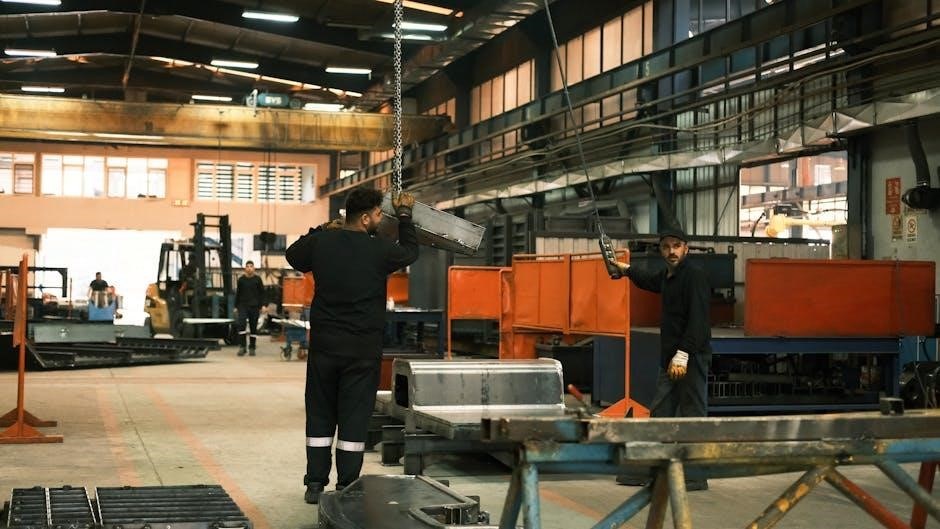The lift manual is a crucial document providing guidelines for safe operation and maintenance of lifts, ensuring user safety and equipment longevity, available online as downloadable resources and printed materials for reference purposes always.
Definition and Importance of Lift Manual
A lift manual is a comprehensive guide that provides detailed information on the safe operation, maintenance, and repair of lifts. The importance of a lift manual cannot be overstated, as it plays a critical role in ensuring the safety of users and preventing accidents. According to online resources, a lift manual typically includes information on the proper use of lifts, safety precautions, and troubleshooting techniques. It also provides guidelines for regular maintenance checks, which are essential for extending the lifespan of the lift. Furthermore, a lift manual serves as a valuable resource for operators, technicians, and maintenance personnel, helping them to perform their duties efficiently and effectively. By following the guidelines and instructions outlined in a lift manual, users can minimize the risk of accidents and ensure a safe working environment. Overall, a lift manual is an essential document that should be readily available to all users of lifts.
Purpose of Lift Manual in Ensuring Safety
The primary purpose of a lift manual is to ensure the safety of users and prevent accidents. A lift manual provides critical information on safety procedures, emergency protocols, and proper operating techniques. By following the guidelines outlined in a lift manual, users can minimize the risk of injury or damage to equipment. The manual also serves as a training tool, educating users on the importance of safety and the consequences of poor manual handling. Online resources emphasize the need for lift manuals to be readily available and easily accessible to all users. Additionally, a lift manual helps to identify potential hazards and provides instructions on how to mitigate them. By prioritizing safety and adhering to the guidelines outlined in a lift manual, users can create a safe working environment and prevent accidents. Overall, the purpose of a lift manual is to promote safety and responsible lift operation, and its importance should not be underestimated. Regular review of the manual is essential to ensure safety protocols are up to date.

Types of Lifts and Their Manuals
Various lifts require specific manuals, including forklifts, hydraulic lifts, and pallet trucks, each with unique operational guidelines and safety protocols always available online for reference purposes only.
Manual Forklifts and Their Operation
Manual forklifts are widely used in various industries due to their versatility and cost-effectiveness, requiring proper operation and maintenance to ensure safe and efficient use. The operation of manual forklifts involves careful planning and execution, taking into account factors such as load weight, size, and balance. Operators must be trained to handle the forklift correctly, using proper lifting techniques and following established safety protocols. Regular maintenance is also crucial to prevent accidents and extend the lifespan of the forklift. This includes checking the condition of tires, brakes, and other critical components, as well as performing routine cleaning and lubrication. By following the guidelines outlined in the lift manual, operators can minimize the risk of injury and ensure the smooth operation of manual forklifts in their workplace. Additionally, the manual provides detailed instructions on how to handle specific tasks, such as loading and unloading cargo, navigating tight spaces, and managing steep inclines.
Hydraulic Lifts and Their Maintenance
Hydraulic lifts are complex machines that require regular maintenance to ensure optimal performance and safety, as outlined in the lift manual. The maintenance of hydraulic lifts involves checking the hydraulic fluid levels, inspecting the hoses and pipes for signs of wear or damage, and replacing the fluid and filters as recommended. It is also essential to lubricate the moving parts and check the electrical systems to prevent overheating or electrical failures. The lift manual provides detailed instructions on how to perform these tasks, as well as troubleshooting guides to help diagnose and repair common problems. Regular maintenance can help extend the lifespan of the hydraulic lift, reduce downtime, and prevent costly repairs. By following the maintenance schedule outlined in the lift manual, operators can ensure the safe and efficient operation of hydraulic lifts, minimizing the risk of accidents and injuries. Proper maintenance also helps to maintain the lift’s certification and compliance with regulatory requirements.

Lift Safety and Precautions

Lift safety and precautions are critical to preventing accidents, ensuring proper training and equipment inspection is essential for safe lift operation and maintenance purposes always online.
Proper Lifting Techniques to Avoid Injuries
Proper lifting techniques are essential to avoid injuries when operating lifts, as they help prevent strain and damage to the equipment and the operator. The lift manual provides guidelines on how to lift safely, including the importance of maintaining a stable center of gravity and using proper body mechanics. It also emphasizes the need to inspect the lift and the load before operation, to ensure that everything is in good working condition. By following these guidelines, operators can minimize the risk of accidents and ensure a safe working environment. Additionally, proper lifting techniques can help reduce the risk of long-term damage to the operator’s body, such as back strain and musculoskeletal disorders. The lift manual is a valuable resource for operators, providing them with the knowledge and skills they need to operate lifts safely and efficiently. Regular training and practice are also essential to develop proper lifting techniques.
Consequences of Poor Manual Handling
Poor manual handling can have severe consequences, including workplace injuries, equipment damage, and decreased productivity. The lift manual emphasizes the importance of proper manual handling techniques to prevent these consequences. When manual handling is not done correctly, it can lead to accidents, such as dropped loads, crushed objects, and operator injuries. These accidents can result in costly repairs, medical expenses, and lost workdays. Furthermore, poor manual handling can also lead to equipment wear and tear, reducing its lifespan and requiring frequent maintenance. The consequences of poor manual handling can be far-reaching, affecting not only the operator but also the entire organization. It is essential to follow the guidelines outlined in the lift manual to ensure safe and efficient manual handling practices. By doing so, operators can minimize the risk of accidents and ensure a safe working environment. Regular training and supervision are also crucial to prevent poor manual handling practices.

Lift Maintenance and Repair
Regular maintenance and repair are essential for lift longevity, involving routine checks and replacements of worn parts to ensure optimal performance and safety always using online resources.
Regular Maintenance Checks for Lifts
Regular maintenance checks for lifts are crucial to ensure the safety and efficiency of the equipment. The lift manual provides guidelines for routine inspections and maintenance tasks, such as checking wire ropes, lubricating moving parts, and replacing worn components. These checks help to identify potential issues before they become major problems, reducing the risk of accidents and downtime. By following the recommended maintenance schedule, lift owners and operators can extend the lifespan of the equipment, reduce maintenance costs, and ensure compliance with regulatory requirements. The Internet provides a wealth of resources and information on lift maintenance, including downloadable manuals, instructional videos, and troubleshooting guides. Additionally, many lift manufacturers offer training programs and technical support to help customers perform routine maintenance tasks and repairs. Regular maintenance checks are essential for ensuring the safe and reliable operation of lifts, and should be performed by qualified personnel only.
Troubleshooting Common Lift Problems
Troubleshooting common lift problems is an essential skill for lift owners and operators, and the lift manual provides a valuable resource for identifying and resolving issues. The manual typically includes a troubleshooting guide that outlines common problems, such as faulty controls, uneven lifting, and strange noises, along with potential causes and solutions. By following the troubleshooting guide, users can quickly identify the root cause of the problem and take corrective action to get the lift back in operation. Online resources, such as forums and technical support websites, can also provide helpful tips and advice for troubleshooting lift problems. Additionally, many lift manufacturers offer technical support and repair services to help customers resolve complex issues. Effective troubleshooting requires a thorough understanding of the lift’s mechanical and electrical systems, as well as the ability to interpret error messages and diagnostic codes. By using the lift manual and online resources, users can develop the skills and knowledge needed to troubleshoot common lift problems.
